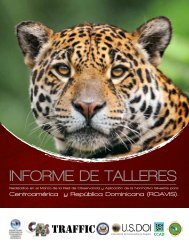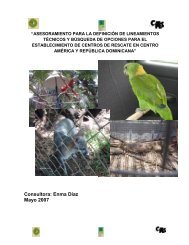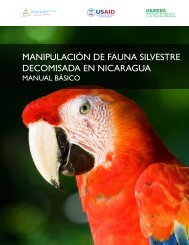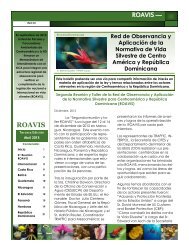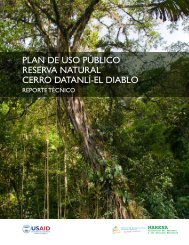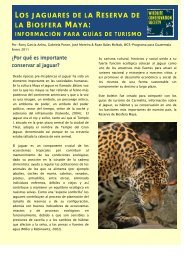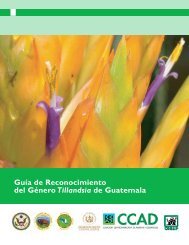Updated Listings of Fauna and Flora Species - caftadr-environment ...
Updated Listings of Fauna and Flora Species - caftadr-environment ...
Updated Listings of Fauna and Flora Species - caftadr-environment ...
- No tags were found...
You also want an ePaper? Increase the reach of your titles
YUMPU automatically turns print PDFs into web optimized ePapers that Google loves.
UPDATED LISTINGS OF FLORA AND FAUNA SPECIESINCLUDED IN THE CITES APPENDICES DISTRIBUTED IN CENTRAL AMERICA AND DOMINICAN REPUBLICMethodologyThe information on CITES species listings for Central America <strong>and</strong> the Dominican Republic was created based on thecompilation <strong>of</strong> information on plants <strong>and</strong> animals contained in the following documents:1. “Taxonomic Update <strong>and</strong> CITES Plant <strong>Species</strong> Distribution in Central America <strong>and</strong> the Dominican Republic”, a productdeveloped in 2007 by the consulting firm Asesorías Ambientales VIMU-GAIA-EON SRL (VIGAE SRL) for theNational Institute <strong>of</strong> Biodiversity (INBio) with financial support from the Government <strong>of</strong> Norway, as part <strong>of</strong>the project “Building capacities <strong>and</strong> Sharing Technology for Biodiversity Management in Central America”, thatincludes nearly one million plant specimen entries collected in the region <strong>and</strong> the Dominican Republic.2. “Review <strong>and</strong> Update <strong>of</strong> CITES <strong>Fauna</strong> <strong>Listings</strong> <strong>of</strong> DR-CAFTA Countries”, a consultancy conducted during the2008-2009 period by the Regional Institute <strong>of</strong> Biodiversity (IRBio) for the Central American Commission <strong>of</strong>Environment <strong>and</strong> Development (CCAD), with financial support from the US Government, as part <strong>of</strong> USAID-CCAD Cooperative Agreement. This information was validated through national workshops involving specialistson different fauna taxa from each country. Given that is the consultancy was completed through the DR-CAFTAFree Trade Agreement, listings from Belize <strong>and</strong> Panama were not included.Both documents are included in digital format in a CD-ROM attached to this publication, thus the methodologydeveloped for each <strong>of</strong> those investigations is included in the attached documentation.For the development <strong>of</strong> the document “UPDATED LISTINGS OF FAUNA AND FLORA SPECIES INCLUDED INCITES APPENDICES AND DISTRIBUTED IN CENTRAL AMERICA AND DOMINICAN REPUBLIC”, listingswere reviewed in order to verify that they contained the updated information. Considering that Belize <strong>and</strong> Panama werenot included here, the updating process <strong>of</strong> these lists was conducted in this phase for both countries, with the intention<strong>of</strong> having complete regional listings for both taxa.The review was performed by obtaining the general listings from the database managed by the World ConservationMonitoring Center (UNEP-WCMC) as a primary source, as well as the CITES <strong>Species</strong> Annoted Listing (CITES2008) generated by the CITES Secretariat, <strong>and</strong> a review <strong>of</strong> various other types <strong>of</strong> material that included information onCITES plant <strong>and</strong> animal species in the countries <strong>of</strong> the Central American region <strong>and</strong> the Dominican Republic.Below is the detailed methodology for each aspect considered in this project:1. Obtention <strong>of</strong> CITES listings <strong>and</strong> national listings <strong>of</strong> CITES <strong>Species</strong>Conducted a search <strong>of</strong> the <strong>of</strong>ficial websites <strong>of</strong> each country, as well as that <strong>of</strong> the UNEP-WCMC.; Searched theCITES annotated listings; completed a literature review, <strong>and</strong> made inquiries to the Administrative Authorities fromeach country, in order to verify the information contained in the lists in collaboration with pr<strong>of</strong>essionals from theregion. Through this process, created a database <strong>of</strong> the species that have to be included in the Appendices.Upon obtention <strong>of</strong> these databases, conducted a review <strong>of</strong> each <strong>of</strong> the species included in the Appendices, verifying thatevery one <strong>of</strong> them was included in the listings. As previously mentioned, UNEP-WCMC listings do not include all thespecies <strong>of</strong> the region, so the verification <strong>of</strong> which species were included <strong>and</strong> which were not was <strong>of</strong> great importance.The species not included were then added <strong>and</strong> the following data was reviewed: phyllum, class, order, family, genus,species, synonyms, distribution range, authors, years, orthography, <strong>and</strong> common names, among others, supported bylistings provided by the countries <strong>and</strong> by reviews made by several specialists from the countries, which facilitated theinclusion <strong>of</strong> species.These base listings <strong>and</strong> the literature review allowed the creation <strong>and</strong> review <strong>of</strong> annotated listings included in thisdocument. In the work completed for fauna (IRBio 2009), the inclusion <strong>of</strong> Panama <strong>and</strong> Belize was not considered,<strong>and</strong> for that reason these two countries were included in this review, starting the process with the database provided byUNEP–WCMC, the CITES Appendices, <strong>and</strong> the literature review, as well as enquiries made to specialists from thesecountries, as suggested by CITES Authorities.2. FLORA ResearchIn the flora listing, each species obtained from the previous database was cross-verified on the database <strong>of</strong> W3TROPICOS(http://www.tropicos.org/) from the Missouri Botanical Garden, in addition to a review <strong>of</strong> the Central AmericanHerbariums website (http://ceiba.inbio.ac.cr/pres/PresentationServlet?action=home), where entries by each countrywere obtained for families such as: Orchidaceae, Cactaceae, <strong>and</strong> Cyathaceae, from the following sources: El Salvador,a database from the Herbarium <strong>of</strong> the Natural History Museum <strong>of</strong> El Salvador (MUHNES); Guatemala, the databasefrom the Missouri Botanical Garden (MOBOT); Honduras, the MOBOT database <strong>and</strong> the Paul C. St<strong>and</strong>ley Herbariumdatabase from the “El Zamorano” Panamerican Agriculture School (EHPZ); for Nicaragua, the Miguel Ramirez GoyenaHerbarium database from the National Autonomous University <strong>of</strong> Nicaragua in León (HULE); Panama, the MOBOTdatabase <strong>and</strong> the Smithsonian Institution (SCZ) Herbarium database; <strong>and</strong> for Costa Rica, the INBio database (CR-INBIO) <strong>and</strong> the National Herbarium (MN-CR) database, at the National Museum. For the Dominican Republic,the information was obtained from the Environment <strong>and</strong> Natural Resources Secretariat website <strong>and</strong> from a site whereendangered species are listed for the Orchidaceae <strong>and</strong> Cactaceae families (Marcano 2007). With this information, thequantity <strong>of</strong> species was increased <strong>and</strong> the species were verified primarily for these families.Specialists from Panama, Honduras, <strong>and</strong> the Dominican Republic provided input on the observations made to the2007 work, <strong>and</strong> other specialists also supported the review with their observations <strong>and</strong> book recommendations. Panamain particular requested that the work be based on the research <strong>of</strong> Correa et al. 2004, <strong>and</strong> Honduras, which requested thework be guided by the research <strong>of</strong> C. Nelson 2008, a request that led to more complete listings.Orchidaceae <strong>and</strong> Cactaceae required further investigation, given that the complete family is included. Reservationsremain with regard to the orchids listing, given that this is one <strong>of</strong> the groups on which more work has been done, <strong>and</strong>there have been constant changes in nomenclature; therefore there is no certainty about which belong to the samespecies, <strong>and</strong> many are accepted under three different names, all <strong>of</strong> them included in the listings. Another interestingaspect revealed by the investigation was that several countries <strong>of</strong> the region still use names which are no longer acceptedorare not current, making it difficult to identify the species. Consequently, the orchid group section is an annotated list<strong>of</strong> species <strong>and</strong> by no means is a systematic review or a nomenclature work.Since trade regulation <strong>of</strong> tree ferns is important, they were included only as Cyathea spp. <strong>and</strong> Dicksonia spp., althoughsome may currently have a different nomenclature.Another important aspect that needs to be emphasized is that non-native species may be ocassionally found in a countrylisting, but they are included because they are species that were introduced <strong>and</strong> are now grown <strong>and</strong> traded from CentralAmerican <strong>and</strong> Dominican Republic.1415



